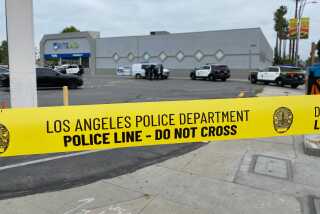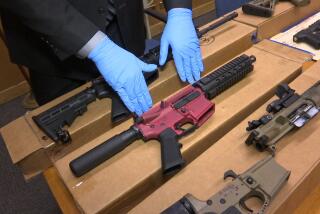Op-Ed: Why the police shouldn’t use Glocks
Timothy Stansbury died in a New York housing project stairwell in 2004 because he startled a police officer. The officer’s surprise at encountering Stansbury caused the officer’s hand to clench and his weapon to fire. The death was ruled accidental by a grand jury, though the officer was later stripped of his gun for the remainder of his career.
Akai Gurley died in another New York housing project stairwell last fall. A rookie officer with his finger on the trigger of his pistol tensed as he pushed open a stuck door; the added pressure on the trigger caused his weapon to fire a shot down the stairwell. The round ricocheted off the wall to strike Gurley. Though the shot wasn’t intentional and the officer didn’t even know Gurley was there, the death has been ruled a criminal homicide, and the officer’s trial is pending.
In both of these incidents, the police officers were using the same weapon, a Glock: a polymer-frame, striker-fired pistol with a short trigger pull and no external safeties.
It’s a popular handgun for law enforcement in New York and beyond. The Los Angeles Police Department has a number of firearms approved for use, including nine Glock models. The Los Angeles County Sheriff’s Department recently began issuing new recruits the Smith & Wesson M&P, a handgun with a short trigger pull that operates in much the same way.
Glock uses the marketing term “Safe Action” to describe its firing-pin system, but the truth is that Glocks are accident-prone. They contributed to more than 120 accidental discharges in the Washington Metropolitan Police Department from 1988 to 1998. Anecdotes of increased accidental shootings have followed the pistol for more than 30 years wherever it has been adopted by police officers and citizens alike.
Just last month, Ocala, Fla., Police Officer Jared Forsyth was shot and killed by a fellow officer after a Glock training session. The fellow officer failed to do a chamber check before pulling the trigger as part of the handgun’s normal disassembly procedure. When the gun fired, the bullet went through a gap in Forsyth’s body armor. Despite the efforts of paramedics to keep him alive, the young officer died on the way to a hospital.
In terms of mechanical design, there are few flaws with Glock pistols. If a law enforcement officer, soldier or citizen does exactly what they are supposed to do all of the time with cyborg certainty, there will be no problems with the Glock or other popular pistols mimicking its basic design. Unfortunately, “RoboCop” is only a movie, and humans are liable to make similar mistakes over and over again.
The underlying problem with these pistols is a short trigger pull and the lack of an external safety. In real-world encounters, a short trigger pull can be lethal, in part because a significant percentage of law enforcement officers — some experts say as high as 20% — put their finger on the trigger of their weapons when under stress. According to firearms trainers, most officers are completely unaware of their tendency to do this and have a hard time believing it, even when they’re shown video evidence from training exercises.
For more than 35 years, officer-involved accidental discharges with Glocks and Glock-like weapons have been blamed on a lack of training or negligence on the part of the individual cops. What critics should be addressing instead is the brutal reality that short trigger pulls and natural human reflexes are a deadly combination.
Though short trigger-pull guns dominate the law enforcement market, they aren’t the only game in town. A number of major and minor agencies use guns with much longer double-action triggers that are just as easy to fire deliberately but that are much harder to fire accidentally. The half-inch difference of trigger travel may not sound like much, but it can be the difference between life and death.
We’ll continue to see more Timothy Stansburys, more Akai Gurleys and more Jared Forsyths until law enforcement agencies and city governments quit listening to hype about how wonderful these systems are from the companies selling the weapons, and start caring more about the lives of their officers and citizens.
Payouts to settle lawsuits over accidental shootings with these weapons have cost cities millions of dollars. Washington, D.C., for instance, paid out $1.4 million in a single six-month period in 1998. And the casualties and lawsuits keep mounting.
Bob Owens is the editor of BearingArms.com. He is an alumnus of Gunsite Academy, a rifle marksmanship instructor with Project Appleseed and the author of the short ebook “So You Want to Own a Gun.”
Follow the Opinion section on Twitter @latimesopinion and Facebook
More to Read
A cure for the common opinion
Get thought-provoking perspectives with our weekly newsletter.
You may occasionally receive promotional content from the Los Angeles Times.










